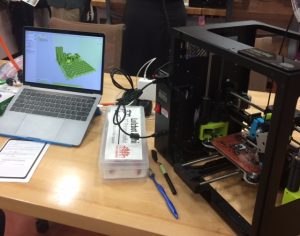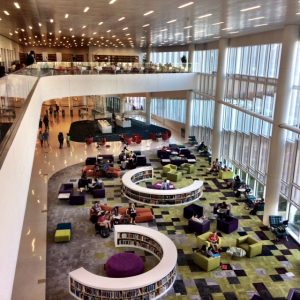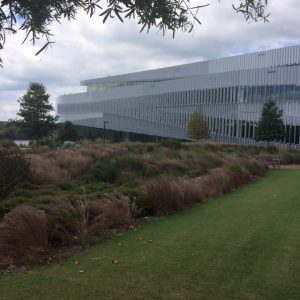Last Wednesday 20+ library staff members came together to talk and learn about usability testing conducted here at Temple University Libraries. This discussion, part of our Assessment Community of Practice, covered a range of topics, from how usability testing is defined, how it is being used, what kinds of data we collect from this method, particular challenges, and changes made based on the assessment. The Community of Practice conversations facilitate us learning from one another, and also model the process of research leading to real changes in how we do library work. Assessment isn’t just evaluative – it leads to action, and new questions.
For me, the meeting fell on the heels the Designing Libraries conference held at the Hunt Library on the campus of North Carolina State University. The building is designed by Snohetta, and it was thrilling to see how the space and services come together to inspire and facilitate all kinds of work – I watched a student in the Hill Library makerspace designing and building an engine with a 3-D printer, and other students deep into reading while ensconced in some very colorful furniture.
Community of practice, to me, connotes mutual learning, shared values, and the sense of engagement and participation between members that is supportive and non-hierarchical. So can spaces foster a community of practice? There were many examples at NC State — makerspaces, virtual reality labs, digital scholarship centers and music rooms, all serve to bring people together for scholarly work that is creative, innovative, and often interdisciplinary.
Lauren Di Monte (Data and Research Impact Librarian, University of Rochester) spoke of using programming to discover user needs, and using programming to drive the development of spaces. Versatile spaces allow for multiple uses, from study to exhibition space to presentation space. She suggests that people are drawn to spaces where something is going on, even when they just want to study.
Jane Alexander (Chief Information/Digital Officer at the Cleveland Museum of Art) provided vivid examples of how digital and physical objects create engagement and community as users are encouraged to experience art in new ways. An example is Gallery One , a 40-foot interactive MicroTile wall that displays over 4000 images of the collections, and users can organize these in multiple ways. (I’m trying to think how we could use this technology for browsing books!)
The conference generated lots of talk of intersections and boundaries, and how we mix pedagogy with fun, how we engage users with the physical through digital, interactive experiences. Spaces, technologies, and services can foster this community. But ultimately, it is the people who share a sense of purpose that move these innovative programs forward.



